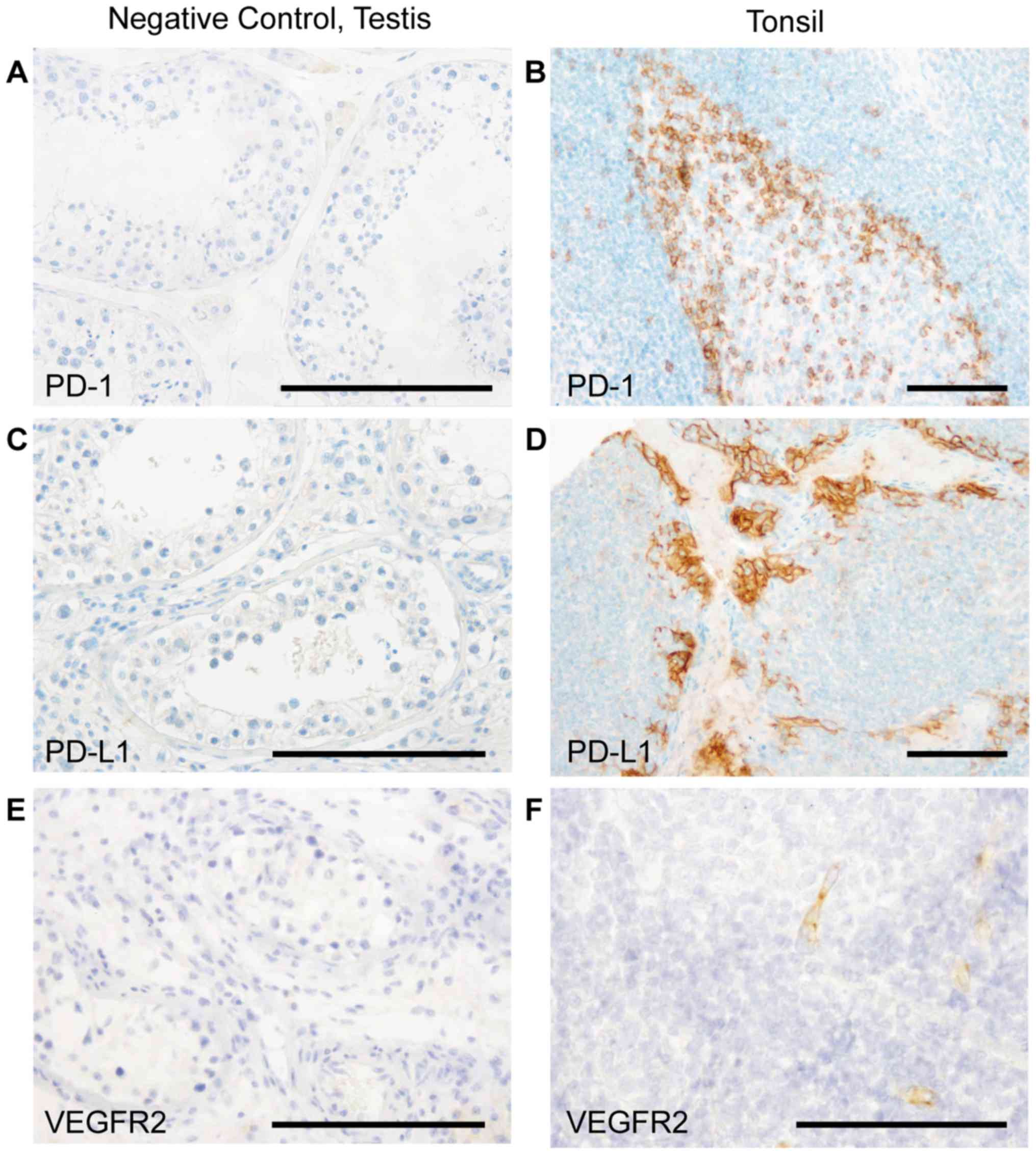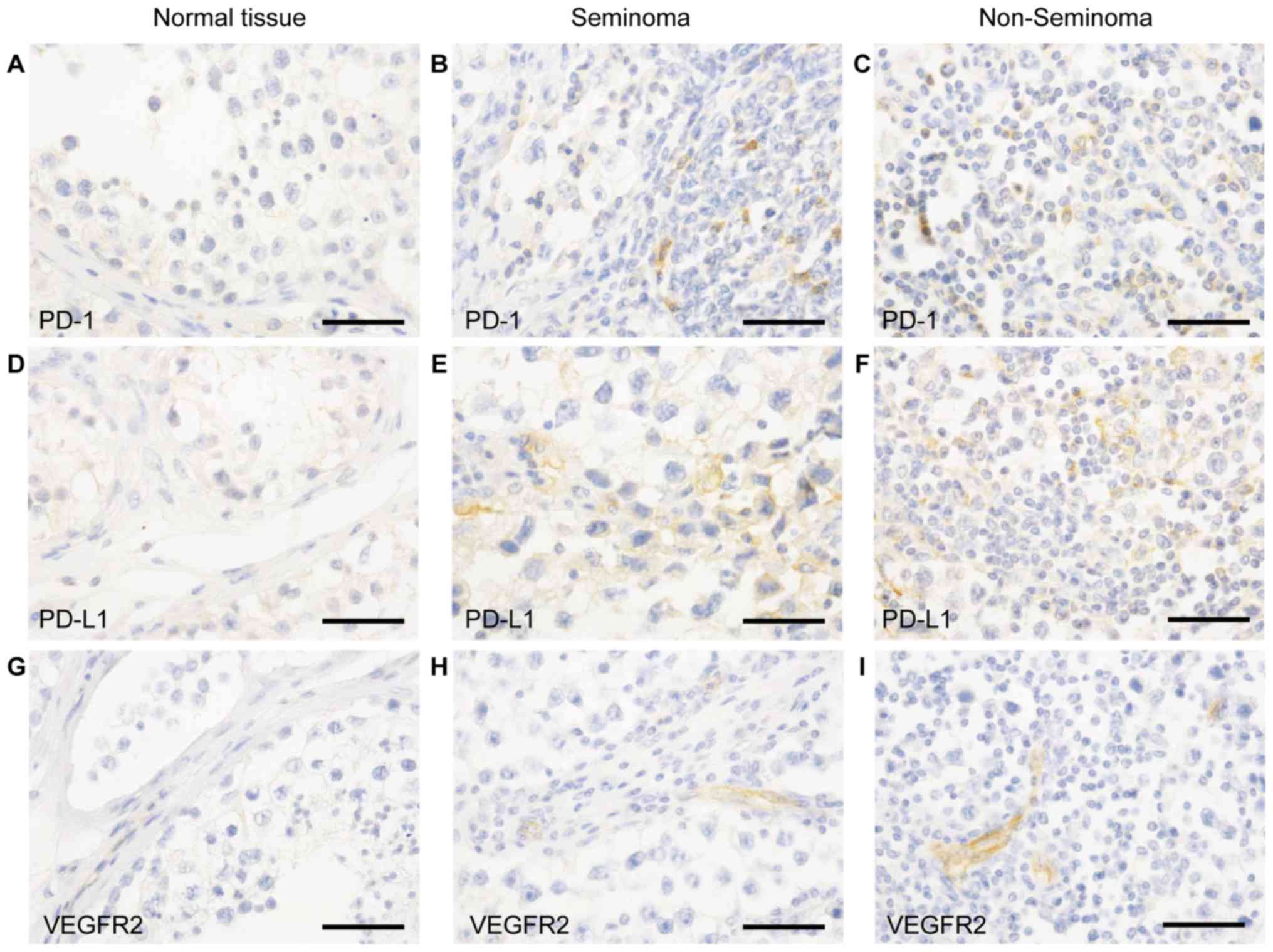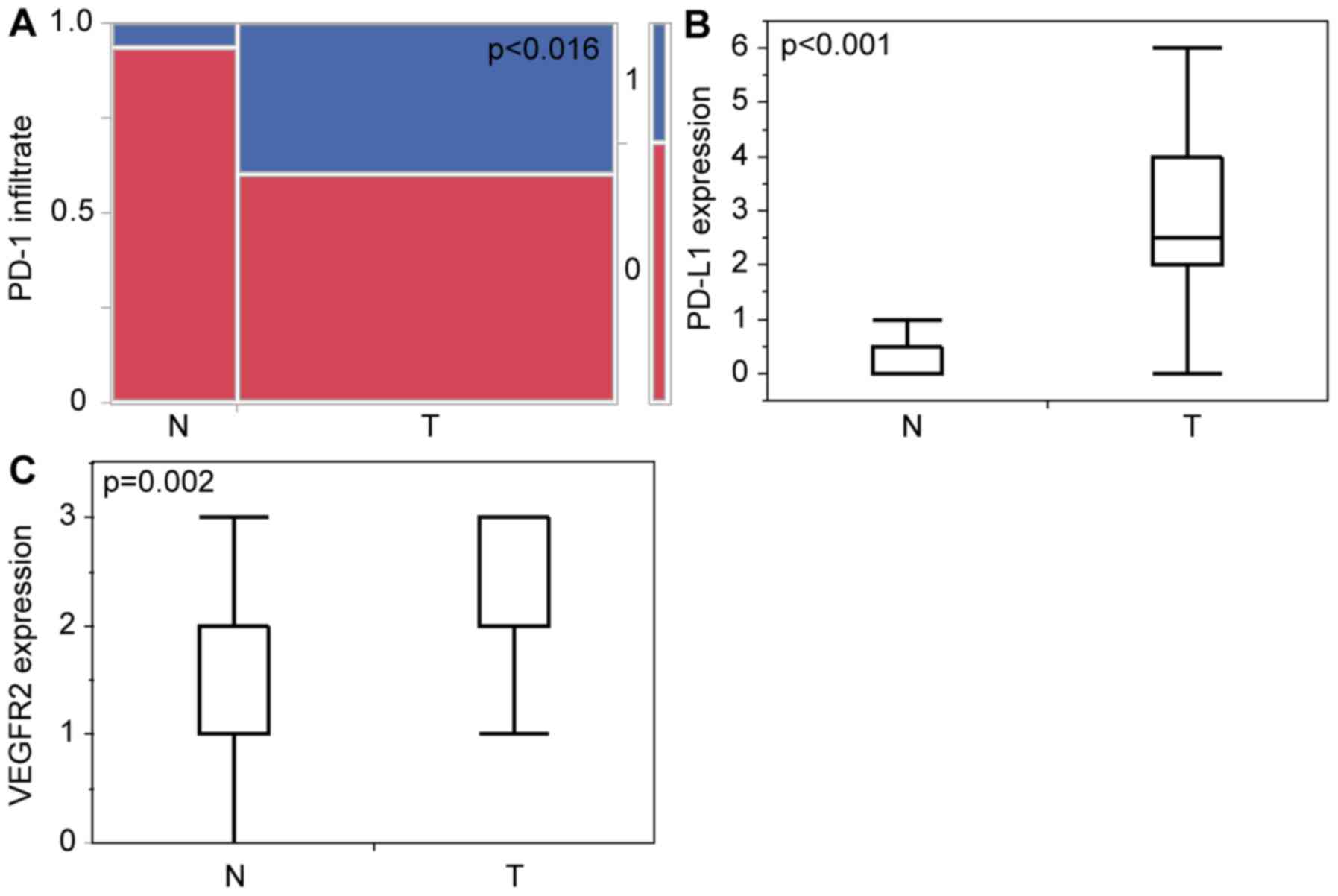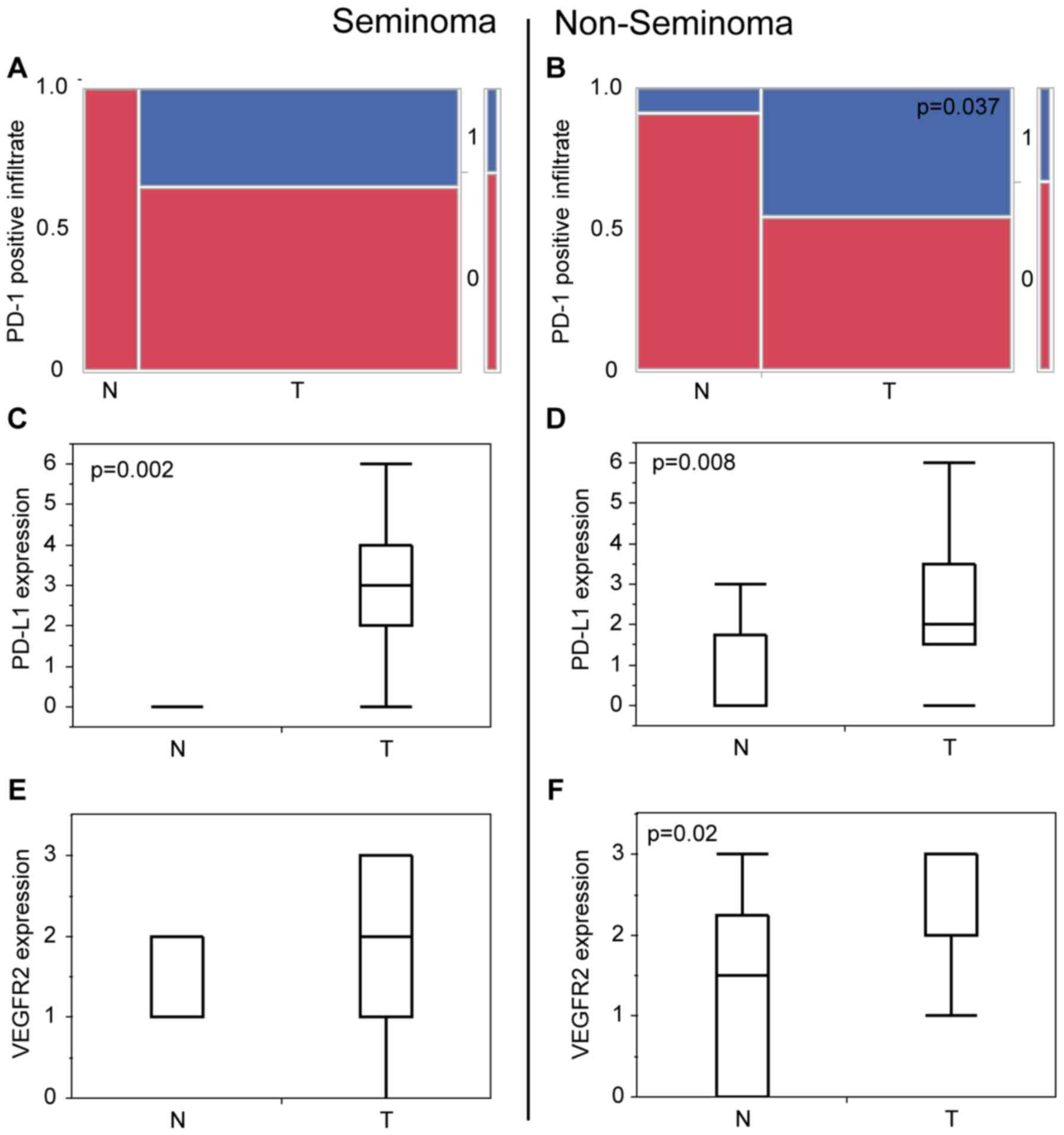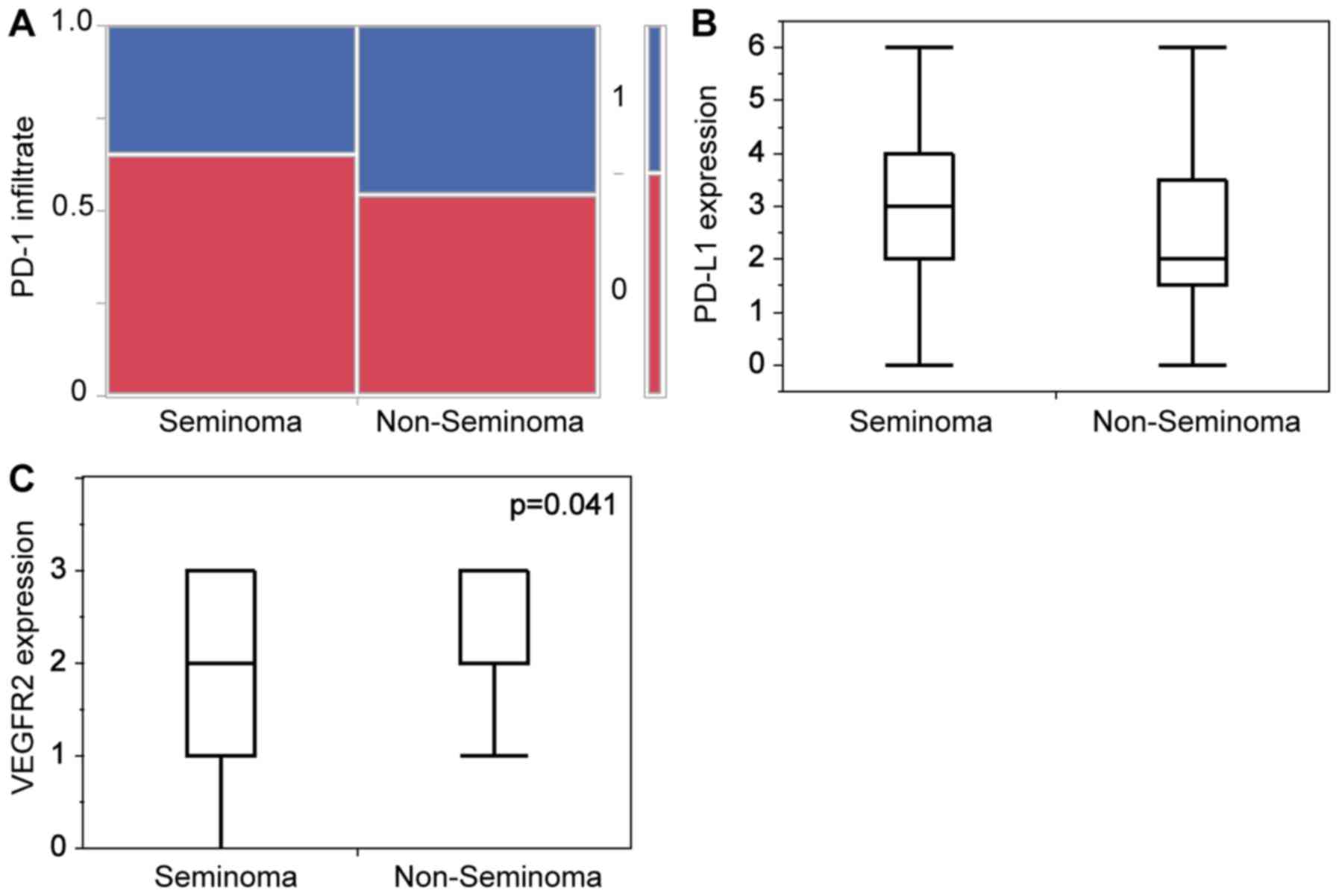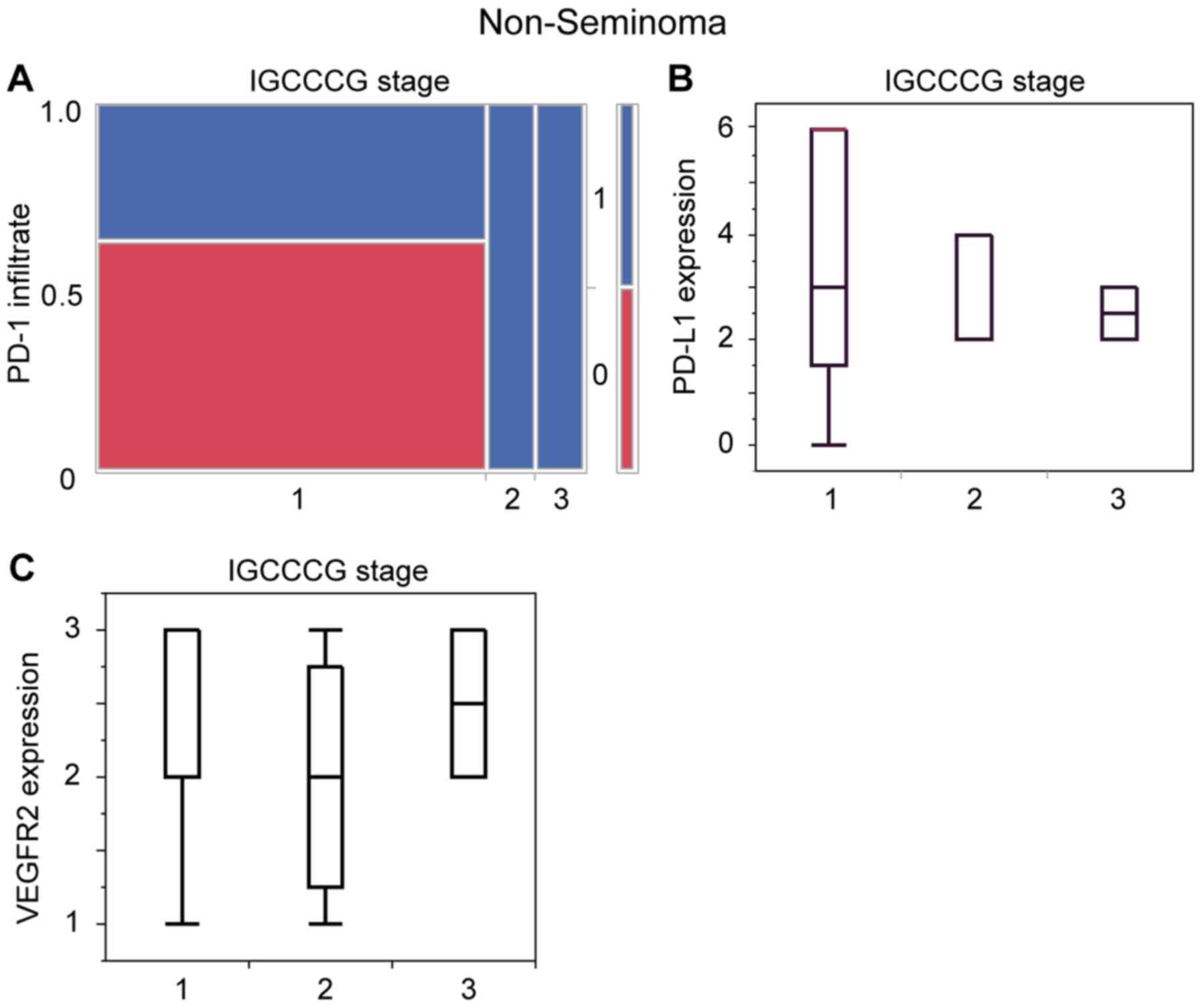|
1
|
Hanna NH and Einhorn LH: Testicular
cancer-discoveries and updates. N Engl J Med. 371:2005–2016. 2014.
View Article : Google Scholar : PubMed/NCBI
|
|
2
|
Mayer F, Stoop H, Scheffer GL, Scheper R,
Oosterhuis JW, Looijenga LH and Bokemeyer C: Molecular determinants
of treatment response in human germ cell tumors. Clin Cancer Res.
9:767–773. 2003.PubMed/NCBI
|
|
3
|
Hussain SA, Ma YT, Palmer DH, Hutton P and
Cullen MH: Biology of testicular germ cell tumors. Expert Rev
Anticancer Ther. 8:1659–1673. 2008. View Article : Google Scholar : PubMed/NCBI
|
|
4
|
Oechsle K, Honecker F, Cheng T, Mayer F,
Czaykowski P, Winquist E, Wood L, Fenner M, Glaesener S, Hartmann
JT, et al: Preclinical and clinical activity of sunitinib in
patients with cisplatin-refractory or multiply relapsed germ cell
tumors: A canadian urologic oncology group/german testicular cancer
study group cooperative study. Ann Oncol. 22:2654–2660. 2011.
View Article : Google Scholar : PubMed/NCBI
|
|
5
|
Farkona S, Diamandis EP and Blasutig IM:
Cancer immunotherapy: The beginning of the end of cancer? BMC Med.
14:732016. View Article : Google Scholar : PubMed/NCBI
|
|
6
|
Sui X, Ma J, Han W, Wang X, Fang Y, Li D,
Pan H and Zhang L: The anticancer immune response of
anti-PD-1/PD-L1 and the genetic determinants of response to
anti-PD-1/PD-L1 antibodies in cancer patients. Oncotarget.
6:19393–19404. 2015. View Article : Google Scholar : PubMed/NCBI
|
|
7
|
Shi L, Chen S, Yang L and Li Y: The role
of PD-1 and PD-L1 in T-cell immune suppression in patients with
hematological malignancies. J Hematol Oncol. 6:742013. View Article : Google Scholar : PubMed/NCBI
|
|
8
|
Escudier B, Motzer RJ, Sharma P, Wagstaff
J, Plimack ER, Hammers HJ, Donskov F, Gurney H, Sosman JA, Zalewski
PG, et al: Treatment beyond progression in patients with advanced
renal cell carcinoma treated with nivolumab in checkmate 025. Eur
Urol. 72:368–376. 2017. View Article : Google Scholar : PubMed/NCBI
|
|
9
|
Mehta K, Patel K and Parikh RA:
Immunotherapy in genitourinary malignancies. J Hematol Oncol.
10:952017. View Article : Google Scholar : PubMed/NCBI
|
|
10
|
Gettinger SN, Horn L, Gandhi L, Spigel DR,
Antonia SJ, Rizvi NA, Powderly JD, Heist RS, Carvajal RD, Jackman
DM, et al: Overall survival and long-term safety of nivolumab
(anti-programmed death 1 antibody, BMS-936558, ONO-4538) in
patients with previously treated advanced non-small-cell lung
cancer. J Clin Oncol. 33:2004–2012. 2015. View Article : Google Scholar : PubMed/NCBI
|
|
11
|
Weber JS, Gibney G, Sullivan RJ, Sosman
JA, Slingluff CL Jr, Lawrence DP, Logan TF, Schuchter LM, Nair S,
Fecher L, et al: Sequential administration of nivolumab and
ipilimumab with a planned switch in patients with advanced melanoma
(CheckMate 064): An open-label, randomised, phase 2 trial. Lancet
Oncol. 17:943–955. 2016. View Article : Google Scholar : PubMed/NCBI
|
|
12
|
Patel SP and Kurzrock R: PD-L1 expression
as a predictive biomarker in cancer immunotherapy. Mol Cancer Ther.
14:847–856. 2015. View Article : Google Scholar : PubMed/NCBI
|
|
13
|
Meng X, Huang Z, Teng F, Xing L and Yu J:
Predictive biomarkers in PD-1/PD-L1 checkpoint blockade
immunotherapy. Cancer Treat Rev. 41:868–876. 2015. View Article : Google Scholar : PubMed/NCBI
|
|
14
|
Rouhi P, Lee SL, Cao Z, Hedlund EM, Jensen
LD and Cao Y: Pathological angiogenesis facilitates tumor cell
dissemination and metastasis. Cell Cycle. 9:913–917. 2010.
View Article : Google Scholar : PubMed/NCBI
|
|
15
|
Huang Y, Yuan J, Righi E, Kamoun WS,
Ancukiewicz M, Nezivar J, Santosuosso M, Martin JD, Martin MR,
Vianello F, et al: Vascular normalizing doses of antiangiogenic
treatment reprogram the immunosuppressive tumor microenvironment
and enhance immunotherapy. Proc Natl Acad Sci USA. 109:17561–17566.
2012. View Article : Google Scholar : PubMed/NCBI
|
|
16
|
Schmid MC and Varner JA: Myeloid cells in
the tumor microenvironment: Modulation of tumor angiogenesis and
tumor inflammation. J Oncol. 2010:2010262010. View Article : Google Scholar : PubMed/NCBI
|
|
17
|
Nitzsche B, Gloesenkamp C, Schrader M,
Hoffmann B, Zengerling F, Balabanov S, Honecker F and Höpfner M:
Anti-tumour activity of two novel compounds in cisplatin-resistant
testicular germ cell cancer. Br J Cancer. 107:1853–1863. 2012.
View Article : Google Scholar : PubMed/NCBI
|
|
18
|
Nitzsche B, Gloesenkamp C, Schrader M,
Ocker M, Preissner R, Lein M, Zakrzewicz A, Hoffmann B and Höpfner
M: Novel compounds with antiangiogenic and antiproliferative
potency for growth control of testicular germ cell tumours. Br J
Cancer. 103:18–28. 2010. View Article : Google Scholar : PubMed/NCBI
|
|
19
|
Einstein DJ and McDermott DF: Combined
blockade of vascular endothelial growth factor and programmed death
1 pathways in advanced kidney cancer. Clin Adv Hematol Oncol.
15:478–488. 2017.PubMed/NCBI
|
|
20
|
International germ cell consensus
classification: A prognostic factor-based staging system for
metastatic germ cell cancers. International germ cell cancer
collaborative group. J Clin Oncol. 15:594–603. 1997. View Article : Google Scholar : PubMed/NCBI
|
|
21
|
Albers P, Albrecht W, Algaba F, Bokemeyer
C, Cohn-Cedermark G, Fizazi K, Horwich A, Laguna MP, Nicolai N and
Oldenburg J: EAU Guidelines Testicular Cancer. European Association
of Urology. 2015.https://uroweb.org/wp-content/uploads/EAU-Guidelines-Testicular-Cancer-2016-1.pdf
|
|
22
|
Baumgarten P, Harter PN, Tönjes M, Capper
D, Blank AE, Sahm F, von Deimling A, Kolluru V, Schwamb B,
Rabenhorst U, et al: Loss of FUBP1 expression in gliomas predicts
FUBP1 mutation and is associated with oligodendroglial
differentiation, IDH1 mutation and 1p/19q loss of heterozygosity.
Neuropathol Appl Neurobiol. 40:205–216. 2014. View Article : Google Scholar : PubMed/NCBI
|
|
23
|
Harter PN, Bernatz S, Scholz A, Zeiner PS,
Zinke J, Kiyose M, Blasel S, Beschorner R, Senft C, Bender B, et
al: Distribution and prognostic relevance of tumor-infiltrating
lymphocytes (TILs) and PD-1/PD-L1 immune checkpoints in human brain
metastases. Oncotarget. 6:40836–40849. 2015. View Article : Google Scholar : PubMed/NCBI
|
|
24
|
Chovanec M, Cierna Z, Miskovska V,
Machalekova K, Svetlovska D, Kalavska K, Rejlekova K, Spanik S,
Kajo K, Babal P, et al: Prognostic role of programmed-death ligand
1 (PD-L1) expressing tumor infiltrating lymphocytes in testicular
germ cell tumors. Oncotarget. 8:21794–21805. 2017. View Article : Google Scholar : PubMed/NCBI
|
|
25
|
Cierna Z, Mego M, Miskovska V, Machalekova
K, Chovanec M, Svetlovska D, Hainova K, Rejlekova K, Macak D,
Spanik S, et al: Prognostic value of programmed-death-1 receptor
(PD-1) and its ligand 1 (PD-L1) in testicular germ cell tumors. Ann
Oncol. 27:300–305. 2016. View Article : Google Scholar : PubMed/NCBI
|
|
26
|
Inaguma S, Wang Z, Lasota J,
Sarlomo-Rikala M, McCue PA, Ikeda H and Miettinen M: Comprehensive
immunohistochemical study of programmed cell death ligand 1
(PD-L1): Analysis in 5536 cases revealed consistent expression in
trophoblastic tumors. Am J Surg Pathol. 40:1133–1142. 2016.
View Article : Google Scholar : PubMed/NCBI
|
|
27
|
Mansfield AS, Aubry MC, Moser JC,
Harrington SM, Dronca RS, Park SS and Dong H: Temporal and spatial
discordance of programmed cell death-ligand 1 expression and
lymphocyte tumor infiltration between paired primary lesions and
brain metastases in lung cancer. Ann Oncol. 27:1953–1958. 2016.
View Article : Google Scholar : PubMed/NCBI
|
|
28
|
Li CW, Lim SO, Xia W, Lee HH, Chan LC, Kuo
CW, Khoo KH, Chang SS, Cha JH, Kim T, et al: Glycosylation and
stabilization of programmed death ligand-1 suppresses T-cell
activity. Nat Commun. 7:126322016. View Article : Google Scholar : PubMed/NCBI
|
|
29
|
Miettinen M, Rikala MS, Rys J, Lasota J
and Wang ZF: Vascular endothelial growth factor receptor 2 as a
marker for malignant vascular tumors and mesothelioma: An
immunohistochemical study of 262 vascular endothelial and 1640
nonvascular tumors. Am J Surg Pathol. 36:629–639. 2012. View Article : Google Scholar : PubMed/NCBI
|
|
30
|
Holzer TR, Fulford AD, Nedderman DM,
Umberger TS, Hozak RR, Joshi A, Melemed SA, Benjamin LE, Plowman
GD, Schade AE, et al: Tumor cell expression of vascular endothelial
growth factor receptor 2 is an adverse prognostic factor in
patients with squamous cell carcinoma of the lung. PLoS One.
8:e802922013. View Article : Google Scholar : PubMed/NCBI
|
|
31
|
Dellinger MT, Meadows SM, Wynne K, Cleaver
O and Brekken RA: Vascular endothelial growth factor receptor-2
promotes the development of the lymphatic vasculature. PLoS One.
8:e746862013. View Article : Google Scholar : PubMed/NCBI
|
|
32
|
Fanoni D, Tavecchio S, Recalcati S, Balice
Y, Venegoni L, Fiorani R, Crosti C and Berti E: New monoclonal
antibodies against B-cell antigens: Possible new strategies for
diagnosis of primary cutaneous B-cell lymphomas. Immunol Lett.
134:157–160. 2011. View Article : Google Scholar : PubMed/NCBI
|
|
33
|
Ilie M, Khambata-Ford S, Copie-Bergman C,
Huang L, Juco J, Hofman V and Hofman P: Use of the 22C3 anti-PD-L1
antibody to determine PD-L1 expression in multiple automated
immunohistochemistry platforms. PLoS One. 12:e01830232017.
View Article : Google Scholar : PubMed/NCBI
|
|
34
|
Li H and Pauza CD: CD25(+) Bcl6(low) T
follicular helper cells provide help to maturing B cells in
germinal centers of human tonsil. Eur J Immunol. 45:298–308. 2015.
View Article : Google Scholar : PubMed/NCBI
|
|
35
|
Misawa Y, Misawa K, Kawasaki H, Imai A,
Mochizuki D, Ishikawa R, Endo S, Mima M, Kanazawa T, Iwashita T and
Mineta H: Evaluation of epigenetic inactivation of vascular
endothelial growth factor receptors in head and neck squamous cell
carcinoma. Tumour Biol. 39:10104283177116572017. View Article : Google Scholar : PubMed/NCBI
|
|
36
|
Solinas C, Garaud S, De Silva P, Boisson
A, Van den Eynden G, de Wind A, Risso P, Vitória Rodrigues J,
Richard F, Migliori E, et al: Immune checkpoint molecules on
tumor-infiltrating lymphocytes and their association with tertiary
lymphoid structures in human breast cancer. Front Immunol.
8:14122017. View Article : Google Scholar : PubMed/NCBI
|
|
37
|
Talay O, Shen CH, Chen L and Chen J: B7-H1
(PD-L1) on T cells is required for T-cell-mediated conditioning of
dendritic cell maturation. Proc Natl Acad Sci USA. 106:2741–2746.
2009. View Article : Google Scholar : PubMed/NCBI
|
|
38
|
Nam-Cha SH, Roncador G, Sanchez-Verde L,
Montes-Moreno S, Acevedo A, Domínguez-Franjo P and Piris MA: PD-1,
a follicular T-cell marker useful for recognizing nodular
lymphocyte-predominant Hodgkin lymphoma. Am J Surg Pathol.
32:1252–1257. 2008. View Article : Google Scholar : PubMed/NCBI
|
|
39
|
Harter PN, Bunz B, Dietz K, Hoffmann K,
Meyermann R and Mittelbronn M: Spatio-temporal deleted in
colorectal cancer (DCC) and netrin-1 expression in human foetal
brain development. Neuropathol Appl Neurobiol. 36:623–635. 2010.
View Article : Google Scholar : PubMed/NCBI
|
|
40
|
Sharma P, Callahan MK, Bono P, Kim J,
Spiliopoulou P, Calvo E, Pillai RN, Ott PA, de Braud F, Morse M, et
al: Nivolumab monotherapy in recurrent metastatic urothelial
carcinoma (CheckMate 032): A multicentre, open-label, two-stage,
multi-arm, phase 1/2 trial. Lancet Oncol. 17:1590–1598. 2016.
View Article : Google Scholar : PubMed/NCBI
|
|
41
|
Okazaki T and Honjo T: PD-1 and PD-1
ligands: From discovery to clinical application. Int Immunol.
19:813–824. 2007. View Article : Google Scholar : PubMed/NCBI
|
|
42
|
Cheng X, Dai H, Wan N, Moore Y,
Vankayalapati R and Dai Z: Interaction of programmed death-1 and
programmed death-1 ligand-1 contributes to testicular immune
privilege. Transplantation. 87:1778–1786. 2009. View Article : Google Scholar : PubMed/NCBI
|
|
43
|
Wang LL, Li ZH, Hu XH, Muyayalo KP, Zhang
YH and Liao AH: The roles of the PD-1/PD-L1 pathway at
immunologically privileged sites. Am J Reprod Immunol. doi:
10.1111/aji.12710.
|
|
44
|
Kaur G, Mital P and Dufour JM:
Testisimmune privilege-Assumptions versus facts. Anim Reprod.
10:3–15. 2013.PubMed/NCBI
|
|
45
|
Zhao S, Zhu W, Xue S and Han D: Testicular
defense systems: immune privilege and innate immunity. Cell Mol
Immunol. 11:428–437. 2014. View Article : Google Scholar : PubMed/NCBI
|
|
46
|
Fankhauser CD, Curioni-Fontecedro A,
Allmann V, Beyer J, Tischler V, Sulser T, Moch H and Bode PK:
Frequent PD-L1 expression in testicular germ cell tumors. Br J
Cancer. 113:411–413. 2015. View Article : Google Scholar : PubMed/NCBI
|
|
47
|
Zhang Y, Kang S, Shen J, He J, Jiang L,
Wang W, Guo Z, Peng G, Chen G, He J and Liang W: Prognostic
significance of programmed cell death 1 (PD-1) or PD-1 ligand 1
(PD-L1) expression in epithelial-originated cancer: A
meta-analysis. Medicine (Baltimore). 94:e5152015. View Article : Google Scholar : PubMed/NCBI
|
|
48
|
Bentas W, Beecken WD, Glienke W, Binder J
and Schuldes H: Serum levels of basic fibroblast growth factor
reflect disseminated disease in patients with testicular germ cell
tumors. Urol Res. 30:390–393. 2003.PubMed/NCBI
|
|
49
|
Adam M, Schmidt D, Wardelmann E, Wernert N
and Albers P: Angiogenetic protooncogene ets-1 induced
neovascularization is involved in the metastatic process of
testicular germ cell tumors. Eur Urol. 44:329–336. 2003. View Article : Google Scholar : PubMed/NCBI
|
|
50
|
Subbiah V, Meric-Bernstam F, Mills GB,
Shaw KR, Bailey AM, Rao P, Ward JF and Pagliaro LC: Next generation
sequencing analysis of platinum refractory advanced germ cell tumor
sensitive to Sunitinib (Sutent®) a
VEGFR2/PDGFRβ/c-kit/FLT3/RET/CSF1R inhibitor in a phase II trial. J
Hematol Oncol. 7:522014. View Article : Google Scholar : PubMed/NCBI
|
|
51
|
Jones A, Fujiyama C, Turner K, Fuggle S,
Cranston D, Turley H, Valtola R, Bicknell R and Harris AL:
Angiogenesis and lymphangiogenesis in stage 1 germ cell tumours of
the testis. BJU Int. 86:80–86. 2000. View Article : Google Scholar : PubMed/NCBI
|
|
52
|
Sakai Y, Hoshino H, Kitazawa R and
Kobayashi M: High endothelial venule-like vessels and lymphocyte
recruitment in testicular seminoma. Andrology. 2:282–289. 2014.
View Article : Google Scholar : PubMed/NCBI
|
|
53
|
Carbognin L, Pilotto S, Nortilli R,
Brunelli M, Nottegar A, Sperduti I, Giannarelli D, Bria E and
Tortora G: Predictive and prognostic role of tumor-infiltrating
lymphocytes for early breast cancer according to disease subtypes:
Sensitivity analysis of randomized trials in adjuvant and
neoadjuvant setting. Oncologist. 21:283–291. 2016. View Article : Google Scholar : PubMed/NCBI
|
|
54
|
Turksma AW, Coupé VM, Shamier MC, Lam KL,
de Weger VA, Belien JA, van den Eertwegh AJ, Meijer GA, Meijer CJ
and Hooijberg E: Extent and location of tumor-infiltrating
lymphocytes in microsatellite-stable colon cancer predict outcome
to adjuvant active specific immunotherapy. Clin Cancer Res.
22:346–356. 2016. View Article : Google Scholar : PubMed/NCBI
|
|
55
|
Yu X, Zhang Z, Wang Z, Wu P, Qiu F and
Huang J: Prognostic and predictive value of tumor-infiltrating
lymphocytes in breast cancer: A systematic review and
meta-analysis. Clin Transl Oncol. 18:497–506. 2016. View Article : Google Scholar : PubMed/NCBI
|
|
56
|
Zeng DQ, Yu YF, Ou QY, Li XY, Zhong RZ,
Xie CM and Hu QG: Prognostic and predictive value of
tumor-infiltrating lymphocytes for clinical therapeutic research in
patients with non-small cell lung cancer. Oncotarget.
7:13765–13781. 2016. View Article : Google Scholar : PubMed/NCBI
|
|
57
|
Coussens LM, Zitvogel L and Palucka AK:
Neutralizing tumor-promoting chronic inflammation: A magic bullet?
Science. 339:286–291. 2013. View Article : Google Scholar : PubMed/NCBI
|
|
58
|
Jain RK: Normalization of tumor
vasculature: An emerging concept in antiangiogenic therapy.
Science. 307:58–62. 2005. View Article : Google Scholar : PubMed/NCBI
|
|
59
|
Schlom J: Therapeutic cancer vaccines:
Current status and moving forward. J Natl Cancer Inst. 104:599–613.
2012. View Article : Google Scholar : PubMed/NCBI
|















